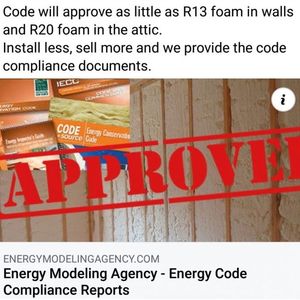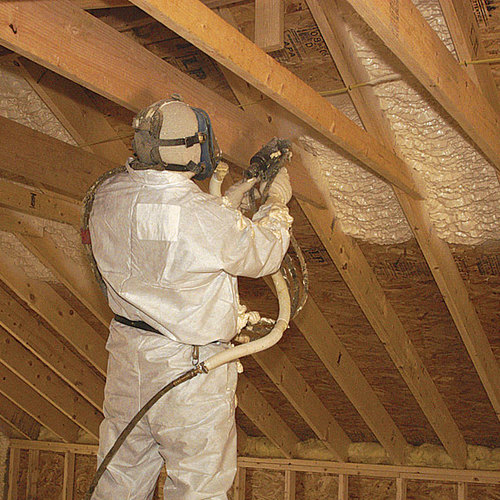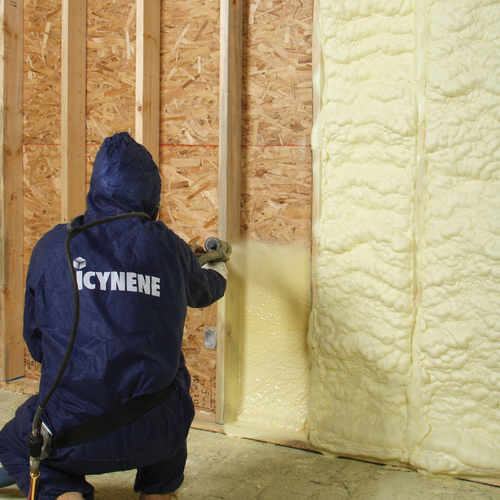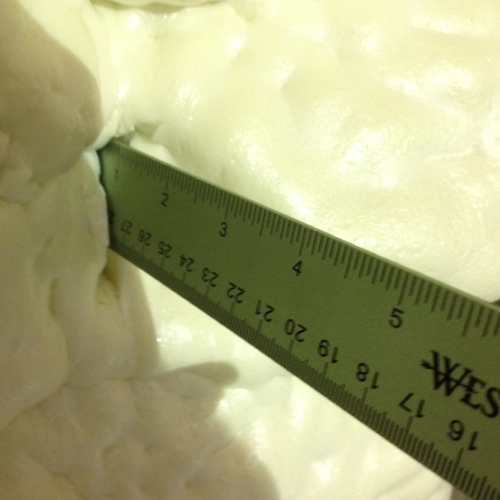
Back in 2010, I wrote an article condemning certain deceptive sales practices by Icynene, a spray foam manufacturer. In that article, I discussed inaccuracies in a letter written and signed by Viktor Ginic, an engineer who was then employed by Icynene. Ginic wrote, “Based on measured air infiltration and the number of energy analyses performed, we have found that Icynene, installed in accordance with the manufacturer’s installation instructions to a nominal thickness of 3″ in the walls and floors and 6″ in roof/ceiling applications, will perform better thermally than R-19 and R-38 air-permeable mineral fiber insulation.”
Back in 2010, all Icynene spray foam was open-cell spray foam. Since 3 inches of open-cell Icynene has an R-value of R-11, it’s simply untrue that it performs better than R-19 mineral fiber insulation. Nor will 6 inches of open-cell Icynene (R-22) perform as well as R-38 mineral fiber insulation.
Needless to say, Icynene was unhappy to have a spotlight shone on their letter. (My article garnered 311 comments, and is still published on the GBA site.)
Deceptive letters are still circulating
Unfortunately, deceptive letters like the one distributed by Icynene are still being circulated by unscrupulous spray foam contractors. In late February, another example of these “Hall of Shame” letters was shared by a GBA reader named Russell Miller.
Two of these deceptive letters are posted on the web site of a spray foam contractor, J. Anderson Insulation of Belleville, Illinois. The letterhead on the letters reads “EnergyWise, 1303 Lee Street, McKinney, Texas 75069.” EnergyWise is still in business, although its current address is 1111 West Mockingbird Lane, Suite 1345, Dallas, Texas 75247.
The letters aren’t recent. They are dated May 3, 2011, and signed by Richard L. Rue and Michael R. Busby, PhD. Because the letters focus on the performance of spray foam manufactured by Lapolla, a spray foam manufacturer with…
Weekly Newsletter
Get building science and energy efficiency advice, plus special offers, in your inbox.

This article is only available to GBA Prime Members
Sign up for a free trial and get instant access to this article as well as GBA’s complete library of premium articles and construction details.
Start Free TrialAlready a member? Log in















16 Comments
Martin,
But what if you combine the spray foam with R-12 cedar shingles, an R-10 radiant barrier sheet, and R-20 paint? Now that is a design to "stand by"!
On a serious note, thank you for holding these people accountable.
Rick,
You forgot to include an important element in your suggested assembly: the R-10 bubble wrap.
I like how Mr. Rue carefully selects his words so that his claim can not be tested, since we can't go back to 2011.
If these kinds of claims are illegal, how come no one is going after these guys?
Trevor,
I have a long history of correspondence with attorneys at the Federal Trade Commission. The short version of why the Federal R-Value Rule isn't enforced well is that the FTC has a limited budget, and picks its cases carefully. Many false claims go unchallenged by the FTC for years and years.
The current Republican administration shows many signs that they are reluctant to enforce existing federal regulations, so I'm not holding my breath waiting for the FTC to aid the many victims of false R-value claims.
It would be interesting to see the research that led to these conclusions. Why don't inspectors reject installations that are less than half code minimum? Are these letters used as justification, or is code min insulation generally not enforced?
Paul,
Q. "Why don't inspectors reject installations that are less than half code minimum?"
A. Some of them -- the smart ones -- do. Many other code inspectors have little training in energy issues, and focus instead on issues related to fire safety. (Until recently, most building codes has been almost entirely focused on the issue of fire safety, so it's not too surprising that many code inspectors lack any background in energy issues.)
Predatory spray foam contractors who use these deceptive letters to fool gullible homeowners often work in rural areas, where code inspection is rare or non-existent. The intent of the deceptive letters is to convince homeowners, not building inspectors, that skimping on R-value is a rational decision.
All of that said, I've heard from builders who tell me that they've been involved with projects where code inspectors have allowed thin spray foam insulation -- less than the minimum values in the prescriptive code -- based on letters like the one under discussion here. Like anyone else, code officials make mistakes.
Thank you, Martin, for providing this information. There is enough BS in the building industry to try and filter through, false product claims must be called out.
Thank you for highlighting this jackassery. It's a shame that the fools can't be held accountable and that the general public doesn't know any better.
Martin- so glad I found your articles including "poly/foam under slab." in your diagram you say "NO fines" but I just bought 4 yds of "base rock with fines" to put, then foam, then poly, then slab. Why no fines? impossible? am i ok in dry calif? urgent question! Thanks.
Miggida,
The main purpose of the substrate under your slab is to support it with a compacted base so that it will not settle or crack. That's what you have right now.
It is good practice to include on top of that, a layer of fill with no fines to provide a capillary break, stopping moisture from wicking up to the underside of the slab. This layer can also be used as part of your radon mitigation system.
Can you get away with omitting the top dressing in a dry climate, and rely on the vapour barrier? Very probably. It isn't a practice that is used everywhere, and omitting it doesn't often cause problems. But by doing so you have introduced a risk that isn't there when rock is present. In other words, you have introduced a judgment call, where usually there is no call to make.
Miggida,
It looks like you posted your comment on the wrong page. I think you meant to post it here: "Polyethylene Under Concrete Slabs."
Malcolm has provided you a thorough answer. You're probably OK, but the advice to install crushed stone without fines is still advice I stand by. The layer of crushed stone without fines provides multiple benefits: Better drainage than the material you purchased; a capillary break (unlike the material you purchased); and an opportunity to install radon mitigation piping, if necessary.
Ok, thanks Malcolm & Martin. Ironically I actually put 2" of gravel (which I had leftover from other job) down first, then 2" of base rock with fines. I guess I should have done it the other way around! I have one other question, but I'll go post it in the other article!
Well-done, Martin. This is misinformation which has taken root in the public mind, and will take no small amount of effort to re-educate them. The GBA recommendations are spot-on. Once air-sealing is done, then r-value is r-value, eh?
Yes. Of course, if you choose to use fiberglass batts, you need to do a careful job of installation, so that there are no voids.
Interesting. I was unaware of this, but it's not surprising. Everything is how you word it. Thanks Martin.
Thanks very much for this article Martin.
I ran across this after our foam contractor told me that he always halves the R-value thickness because foam performs so well. We don’t have codes here, but reportedly the codes dept in a nearby city lets foam installers get away with this. If left unchecked we would have had 5-6” of open cell foam on the roof deck and the contractor was calling it R40. He actually believes the hype and told me that in 18 years installing foam I’m only the second person who wanted more than that. Probably because everyone else thought they were getting R40 when they absolutely were not.
Anyway, I hope this article and the comments serve as a cautionary tale to others. As usual, trust but verify.
Cory
Log in or become a member to post a comment.
Sign up Log in